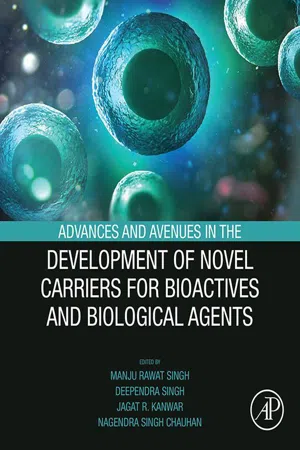
Advances and Avenues in the Development of Novel Carriers for Bioactives and Biological Agents
- 656 pages
- English
- ePUB (mobile friendly)
- Available on iOS & Android
Advances and Avenues in the Development of Novel Carriers for Bioactives and Biological Agents
About This Book
Advances and Avenues in the Development of Novel Carriers for Bioactives and Biological Agents provides sound data on the utility of biological and plant-based drugs and describes challenges faced in all aspects offering indispensable strategies to use in the development of bioactive medicines. Bioactive based medications are commonly used throughout the world and have been recognized by physicians and patients for their therapeutic efficacy. Bioactive formulations, including their subordinates and analogs, address 50% of all medicines in clinical practice. Novel bioactive medicine transporters can cure many disorders by both spatial and transitory approaches and have various justifications in medicinal potential.
This book presents information on the utility of natural, plant, animal and bioengineered bioactive materials. It is a fundamental source of information and data for pharmacognosists, pharmaceutical analysts, drug transport scientists and pharmacologists working in bioactive medications.
- Advances information on various bioactive based medications, their sources, clinical consequences and transport strategies
- Illustrates diverse transport systems for bioactives and derivatives, novel techniques for formulations, targeting strategies and fundamental qualities of developed bioactive carriers, and their safety concerns and standardization
- Discusses distinctive transport systems, stability, upgraded dissolvability, and enhanced bioavailability of bioactives
Frequently asked questions
Information
Challenges and need of delivery carriers for bioactives and biological agents: an introduction
Abstract
Keywords
1.1 Introduction
1.2 Bioactives and biological agents
Table of contents
- Cover image
- Title page
- Table of Contents
- Copyright
- List of Contributors
- Chapter 1. Challenges and need of delivery carriers for bioactives and biological agents: an introduction
- Chapter 2. Natural product–based nanomedicine: polymeric nanoparticles as delivery cargoes of food bioactives and nutraceuticals for anticancer purposes
- Chapter 3. The promising expedition of the delivery systems for monoclonal antibodies
- Chapter 4. Innovative technological systems to optimize the delivery and therapeutic activity of antimicrobial drugs
- Chapter 5. Tailoring drug and gene codelivery nanosystems for glioblastoma treatment
- Chapter 6. Polyelectrolyte multilayers for drug delivery
- Chapter 7. Magnetic nanocarriers of bioactives: structural and delivery system designs
- Chapter 8. Iron bond bovine lactoferrin for the treatment of cancers and anemia associated with cancer cachexia
- Chapter 9. Metallic-based nanocarriers: methods employed in nanoparticle characterization and assessing the interaction with the blood–brain barrier
- Chapter 10. Inorganic-based drug delivery systems for cancer therapy
- Chapter 11. Novel perspectives for delivery of bioactives through blood–brain barrier and treatment of brain diseases
- Chapter 12. Nanoparticle-based delivery of polyphenols for the treatment of inflammation-associated diseases
- Chapter 13. Efficacy of promising flavonoids from Festuca, Lonicera, and Acacia genera against glioblastoma multiforme; potential for the Dandenong Ranges
- Chapter 14. Targeting aspects for bioactive drugs
- Chapter 15. Amphiphilic block copolymer: a smart option for bioactives delivery
- Chapter 16. Rheumatoid arthritis: basic pathophysiology and role of chitosan nanoparticles in therapy
- Chapter 17. Targeted delivery through carbon nanomaterials: applications in bioactive delivery systems
- Chapter 18. Liposomes and phytosomes for phytoconstituents
- Chapter 19. Quality by design and formulation optimization using statistical tools for safe and efficient bioactive loading
- Chapter 20. Commercial aspects and market potential of novel delivery systems for bioactives and biological agents
- Index